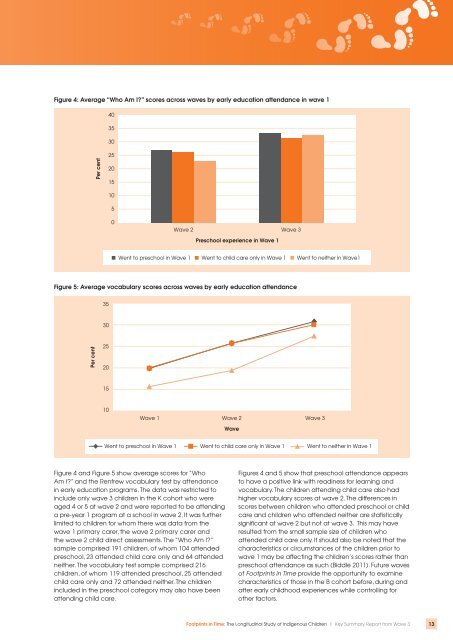Summary Report - pdf - Department of Families, Housing ...
Summary Report - pdf - Department of Families, Housing ...
Summary Report - pdf - Department of Families, Housing ...
Create successful ePaper yourself
Turn your PDF publications into a flip-book with our unique Google optimized e-Paper software.
Figure 4: Average “Who Am I?” scores across waves by early education attendance in wave 1Figure 5: Average vocabulary scores across waves by early education attendanceFigure 4 and Figure 5 show average scores for “WhoAm I?” and the Renfrew vocabulary test by attendancein early education programs. The data was restricted toinclude only wave 3 children in the K cohort who wereaged 4 or 5 at wave 2 and were reported to be attendinga pre-year 1 program at a school in wave 2. It was furtherlimited to children for whom there was data from thewave 1 primary carer, the wave 2 primary carer andthe wave 2 child direct assessments. The “Who Am I?”sample comprised 191 children, <strong>of</strong> whom 104 attendedpreschool, 23 attended child care only and 64 attendedneither. The vocabulary test sample comprised 216children, <strong>of</strong> whom 119 attended preschool, 25 attendedchild care only and 72 attended neither. The childrenincluded in the preschool category may also have beenattending child care.Figures 4 and 5 show that preschool attendance appearsto have a positive link with readiness for learning andvocabulary. The children attending child care also hadhigher vocabulary scores at wave 2. The differences inscores between children who attended preschool or childcare and children who attended neither are statisticallysignificant at wave 2 but not at wave 3. This may haveresulted from the small sample size <strong>of</strong> children whoattended child care only. It should also be noted that thecharacteristics or circumstances <strong>of</strong> the children prior towave 1 may be affecting the children’s scores rather thanpreschool attendance as such (Biddle 2011). Future waves<strong>of</strong> Footprints in Time provide the opportunity to examinecharacteristics <strong>of</strong> those in the B cohort before, during andafter early childhood experiences while controlling forother factors.Footprints in Time: The Longitudinal Study <strong>of</strong> Indigenous Children | Key <strong>Summary</strong> <strong>Report</strong> from Wave 313




![pdf [107kB] - Department of Families, Housing, Community Services](https://img.yumpu.com/51272499/1/190x245/pdf-107kb-department-of-families-housing-community-services.jpg?quality=85)










![Land Claim - pdf [278kB] - Department of Families, Housing ...](https://img.yumpu.com/47002639/1/184x260/land-claim-pdf-278kb-department-of-families-housing-.jpg?quality=85)

![Borroloola Land Claim - pdf [299kB] - Department of Families ...](https://img.yumpu.com/46103973/1/184x260/borroloola-land-claim-pdf-299kb-department-of-families-.jpg?quality=85)